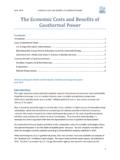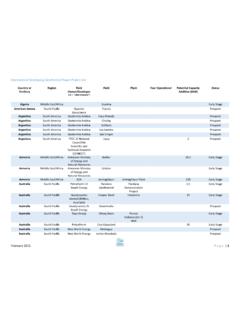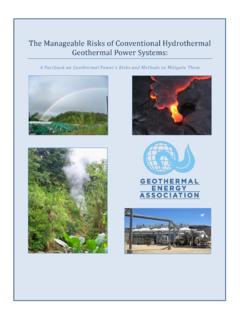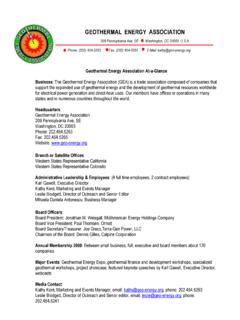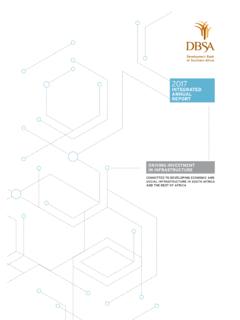Transcription of 2015 Annual U.S. & Global Geothermal Power Production …
1 2015 Annual & Global Geothermal Power Production report Contents Geothermal Power Industry Highlights .. 4 International .. 4 United States .. 4 Methodology and Terms .. 5 Geothermal Resource Types and Their Definitions for Projects .. 5 Tracking Projects through the Development Timeline .. 6 Planned Capacity Addition (PCA) and Resource Capacity .. 6 Geothermal Resource Types and Their Definitions for Global Projects .. 6 International Geothermal Power Update .. 8 Geothermal Power Update .. 12 Market Summary .. 12 Developing Projects .. 13 Global Technology and Manufacturing Update .. 15 Appendix 1: Developing Project List .. 18 Appendix 2: New Power Plants to Come Online in 2014 .. 20 References .. 21 Written and Prepared by Benjamin Matek, Geothermal Energy Association February 2015 Acknowledgments: GEA would like to sincerely thank its member companies, as well as other organizations and individuals, for their cooperation and assistance in gathering the information used in this report .
2 GEA would also like to thank members of its Science and Technology Committee for reviewing this publication before release. GEA would like to thank Sam Abraham for contributing his beautiful photography for use in this publication. Cover Page Top & Bottom Left: Menengai, Kenya; courtesy of Sam Abraham Cover Page Bottom Right: Salton Sea Geothermal Resource Area, California; courtesy of CalEnergy Please Note: The findings, interpretations, and conclusions expressed in this report are entirely those of the author and should not be attributed in any manner to the Geothermal Energy Association, to its affiliated organizations, or to members of its Board of Directors. The Geothermal Energy Association does not guarantee the accuracy of the data included in this publication and accepts no responsibility whatsoever for any consequence of its use.
3 Any reference to any specific commercial product, process, or service by trade name, trademark, manufacturer, or otherwise, does not necessarily constitute or imply an endorsement, recommendation, or favoring by GEA. GEA does not assume, and hereby disclaims, any liability that may result from any reliance on or use of any information contained in this publication, or for any loss or damage caused by errors or omissions in this publication. Geothermal Power Industry Highlights International GEA data shows a total of 21 new Power plants came online in 2014 adding about ~610 MW of new capacity to electricity grids globally. According to GEA statistics this is the most capacity to come online in one year since 1997. This is the third year in a row the Global Geothermal industry has sustained a growth rate of 5%. The Global market is at about GW of operating capacity as of January 2015, spread across 24 countries.
4 This year the Global Geothermal market was developing about GW of planned capacity spread across 80 countries. Based on current data the Global Geothermal industry is expected to reach between GW and GW by 2020. Overall if all countries follow through on their Geothermal Power development goals and targets the Global market could reach 27-30 GW by the early 2030s. Flash technologies, including double and triple flash, make up a little less than two thirds of the Global market (58%), while dry steam is about a quarter (26%) and binary is a remaining 15%. The last remaining 1% includes back pressure and other developing and experimental types of Geothermal technologies. The United Nations this year formed a Global Geothermal Alliance. This alliance was signed by 23 countries. The alliance is a partnership platform among governments for working to reduce the investment risks associated with exploratory drilling, along with the associated costs, which have constituted a main obstacle to Geothermal Power expansion and offers.
5 The World Bank estimates as many as 40 countries could meet a large proportion of their electricity demand through Geothermal Power . Communities and governments around the world have only tapped of the total Global potential for Geothermal Power based on current geologic knowledge and technology. Since 2005, over 160 Geothermal Power projects have been built adding an additional 4 GW to electricity grids across the globe. United States The industry had about GW of installed nameplate capacity and GW of net capacity at the end of 2014. In total the market had about 1,250 MW of Geothermal Power under development with about 500 MW stalled in Phase 3 waiting for Power purchase agreements (PPAs). These are projects that could be brought online in 17-33 months, or sooner with the appropriate Power contracts. Since 2005, the United States has built over 38 Geothermal Power projects adding nearly 700 MW to the electricity capacity.
6 Methodology and Terms To increase the accuracy and value of information presented in its Annual Geothermal Power Production and Development report , the Geothermal Energy Association (GEA) developed a reporting system known as the Geothermal Reporting Terms and Definitions in 2010. The Geothermal Reporting Terms and Definitions serve as a guideline to project developers in reporting Geothermal project development information to the GEA. A basic understanding of the Geothermal Reporting Terms and Definitions will also aid the reader in fully understanding the information presented in this Annual report . The Geothermal Reporting Terms and Definitions serve to increase reporting clarity and accuracy by providing industry and the public with a lexicon of definitions relating to the types of different Geothermal projects, and a guideline for determining which phase of development a Geothermal resource is in.
7 These two tools help to characterize resource development by type and technology. They also help to determine a Geothermal project s position in the typical project development timeline. Geothermal Resource Types and Their Definitions for Projects In reporting a project in development to the GEA, the developer of a Geothermal resource is asked to indicate which of the following definitions the project falls under: Conventional Hydrothermal (Unproduced Resource): the development of a Geothermal resource where levels of Geothermal reservoir temperature and reservoir flow capacity are naturally sufficient to produce electricity and where development of the Geothermal reservoir has not previously occurred to the extent that it supported the operation of Geothermal Power plant(s). Such a project will be labeled as CH Unproduced in this report .
8 Conventional Hydrothermal (Produced Resource): the development of a Geothermal resource where levels of Geothermal reservoir temperature and reservoir flow capacity are naturally sufficient to produce electricity and where development of the Geothermal reservoir has previously occurred to the extent that it currently supports or has supported the operation of Geothermal Power plant(s). Such a project will be labeled as CH Produced in this report . Conventional Hydrothermal Expansion: the expansion of an existing Geothermal Power plant and its associated drilled area so as to increase the level of Power that the Power plant produces. Such a project will be labeled as CH Expansion in this report . Geothermal Energy and Hydrocarbon Co- Production : the utilization of produced fluids resulting from oil and/or gas-field development for the Production of Geothermal Power .
9 Such a project will be labeled as Co- Production in this report . Geopressured Systems: the utilization of kinetic energy, hydrothermal energy, and energy produced from the associated gas resulting from geopressured gas development to produce Geothermal electricity. Such projects will be labeled as Geopressure in this report . Enhanced Geothermal Systems: the development of a Geothermal system, where the natural flow capacity of the system is not sufficient to support adequate Power Production but where hydraulic fracturing of the system can allow Production at a commercial level. Such a project will be labeled as EGS in this report . Tracking Projects through the Development Timeline In addition to defining their projects according to the above list of definitions, GEA also asks developers to indicate projects current status in the project development timeline using a four-phase system.
10 This system captures how much and what type of work has been performed on that particular Geothermal resource up until the present time. These four phases of project development are: Phase I: Resource Procurement and Identification Phase II: Resource Exploration and Confirmation Phase III: Permitting and Initial Development Phase IV: Resource Production and Power Plant Construction Each of the four phases of project development is comprised of three separate sections, each of which contains phase sub-criteria. The three separate sections of sub-criteria are resource development, transmission development, and external development (acquiring access to land, permitting, signing PPAs and EPC contracts, securing a portion of project financing, etc.). For a project to be considered as being in any particular phase of development a combination of sub-criteria, specific to each individual project phase, must be met.
